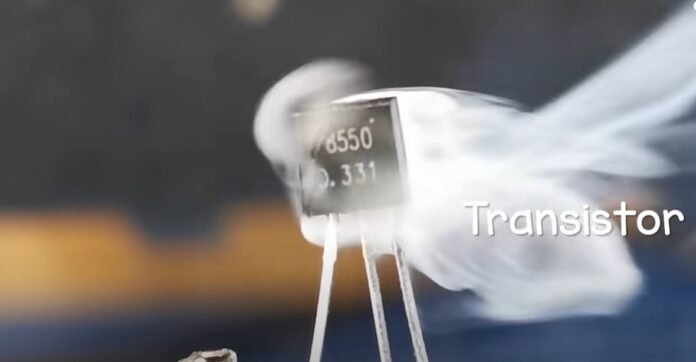Transistors, which are present in practically every electronic component, have evolved into the neurons of the information era. A transistor is a semiconductor device used for electrical signal generation, control, and amplification. Integrated circuits, or “microchips,” frequently have billions of these tiny components etched onto their glossy surfaces and used transistors as their active parts.
The emitter, collector, and base—or, in more recent switching applications, the source, drain, and gate—are the three electrical leads that commonly make up a transistor. A transistor increases the output current by changing the modest input current it receives as an amplifier. It functions as a switch, allowing electronic impulses to pass through an electrical circuit/electronic device in two different states: on or off. Transistors are used in computer memory chips, which include solid-state multimedia storage systems for electronic games, cameras, and MP3 players.
A transistor has three parts: base, emitter, and collector.
Base: The base is light-doped and thin. It may be found at the transistor’s center.
Emitter: The transistor’s emitter is its negative terminal. The emitter is sizable and extensively doped.
Collector: The transistor’s collector is its positive terminal. It is prominent and moderately doped on the right side of a transistor.
Benefits of Transistor
The transistor has established itself as a crucial scientific discovery. There are various benefits and applications for it:
- It is compact and quite economical.
- It operates at a very low voltage.
- It has a long lifespan and runs without power.
- Using a transistor, a single integrated circuit may be created.
- The terminals have a quick current switching.
Uses of Transistors
Amplifier Circuit
Current may be amplified using a transistor. The base becomes negatively charged when electrons begin to flow from the emitter to recombine with holes in the base due to the forward biasing of the base-emitter junction. Hole-electron recombination will be neutralized, and the collector current Ic will increase if the base current Ib is slightly raised. Therefore, a little modification to the base’s present Ib.
Electronic Oscillator
A tool that continuously produces electrical oscillations is known as an electronic oscillator. A parallel LC circuit is utilized as the resonant circuit in a simple oscillator circuit, and an amplifier is used to supply energy to the resonant circuit. Resonantly amplifying the frequency, the output is a source of that frequency’s alternating voltage.
Transistor
BJT transistors can be employed as a switching mechanism to regulate DC power flow to a load. The controlling current flows between the emitter and base, while the switched current travels between the emitter and collector.
Microphone
Our speech or sound wave is transduced into an electrical signal by the microphone, which is a transducer. The base current Ib of the microphone fluctuates according to the sound waves because the microphone produces a little amount of alternating voltage, implying that a minor change in Ib can result in a significant change in Ic.
Memory Chips
In computer memory chips, transistors are one of the most often used components. The transistors in these chips function as small switches that can turn electrical charges used to store information on and off. They can carry a ton of data in a little space, which makes them perfect for data storage. They are moreover fast, which is crucial for computers that need to quickly retrieve big volumes of data.
Switches
By producing a binary on/off effect, transistors function as switches. As a result, voltage rather than an actuator is needed to flip it. The application manages a different area of the circuit’s power flow. To put it another way, a little current running through one portion of a transistor permits a larger current to flow through the remaining portion.
Signal Amplifiers
Transistors can also be used as amplifiers. A little electrical signal is amplified by amplifiers, which makes it stronger. Transistors were originally used commercially in hearing aids and portable radios. Transistors are used in many audio amplification devices nowadays, including stereo systems and amplifiers for musical instruments.
Logic Circuits
Electronic circuits for digital logic also employ transistors. The fundamental components of digital electronics, including computers and smartphones, are called digital logic circuits. Boolean logic operations, the foundation of all digital computations, are carried out by these circuits using transistors.
Recommended Articles:
A transistor can serve as a gate or switch that opens and closes several times per second for electronic signals. It makes sure the circuit is switched on if the current is flowing and off if it is not. The intricate switching circuits that make up contemporary telecommunications networks all require transistors. The words "transfer" and "resistance" are combined to form the word "transistor." This is due to the resistance being transferred from one end of the device to the other, or as it is sometimes called resistance transfer. Due to their fragility, transistors are sensitive to temperature changes. It works as an amplifier. In order to increase the power of a weak signal, a transistor amplifies it by allowing a very little weak signal to enter through the base junction. Through the collector, this amplified signal is emitted. A small signal transistor typically operates between 60 and 80 V. This might reach 1000 V in power transistors. Uses of Transistor FAQs
What is the purpose of a transistor?
Why is it named a transistor?
What are some of the drawbacks of transistors?
Transistors can be harmed by radiation as well.
The transistor has limited electron mobility.Is a transistor also an amplifier?
What voltage can a transistor withstand?
